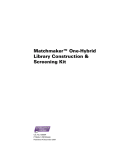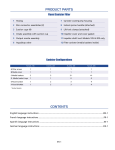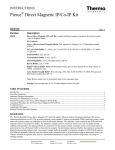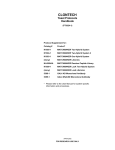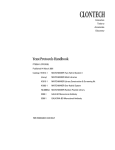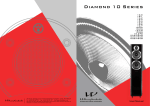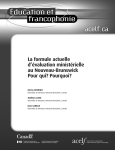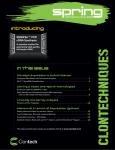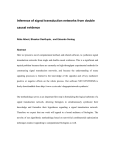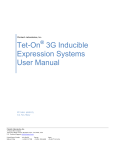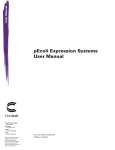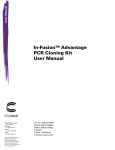Download MATCHMAKER Co
Transcript
User Manual Matchmaker™ Co-IP Kit User Manual United States/Canada 800.662.2566 Asia Pacific +1.650.919.7300 Europe +33.(0)1.3904.6880 Japan +81.(0)77.543.6116 Clontech Laboratories, Inc. A Takara Bio Company 1290 Terra Bella Ave. Mountain View, CA 94043 Technical Support (US) E-mail: [email protected] www.clontech.com Cat. No. 630449 PT3323-1 (PR631535) Published 16 March 2006 Matchmaker™ Co-IP Kit User Manual Table of Contents I. Introduction 3 II. List of Components 6 III. Additional Materials Required 7 IV. Controls 9 V. DNA-BD & AD Insert Screening Protocol 10 VI. In vitro Coimmunoprecipitation 13 A. In vitro Transcription and Translation 13 B. Coimmunoprecipitation and SDS-PAGE Analysis 13 VII. Troubleshooting Guide 16 VIII. References 20 IX. Related Products 21 Appendix A: Expected Results with Positive Control Vectors 23 Appendix B: Adding T7 Promoters and Epitope Tags 24 Appendix C: Vector Information 27 List of Figures Figure 1. Procedural overview of the Matchmaker Co-IP Kit 5 Figure 2. SDS-PAGE analysis shows that murine p53 coimmunoprecipitates with SV40 large T-antigen 23 Figure 3. PCR primers for adding the T7 RNA polymerase promoter, c-Myc-, and HA-epitopes while amplifying inserts in Matchmaker GAL4 vectors 24 Figure 4. Map of pGBKT7-53 DNA-BD Control Vector 27 Figure 5. Map of pGADT7-T AD Control Vector 27 List of Tables Table I. Positive control vectors Table II. Assembling master mixes with Advantage 2 Polymerase Mix (Mg2+ included in the buffer) Clontech Laboratories, Inc. www.clontech.com 9 11 Protocol No. PT3323-1 Version No. PR631435 Matchmaker™ Co-IP Kit User Manual I. Introduction After detecting protein interactions through an in vivo yeast two-hybrid screen, an in vitro biochemical assay is an easy way to confirm true protein interactions. The Matchmaker™ Co-IP Kit allows you to quickly visualize and confirm protein interactions by in vitro coimmunoprecipitation (Co-IP; Figure 1). The Co-IP Kit is compatible with our Matchmaker Two-Hybrid System 3 vectors: pGBKT7 and pGADT7. Derivatives of these vectors such as pGADT7-Rec, pLP-GADT7, and pLP-GBKT7 are also compatible. All these vectors already contain a T7 RNA polymerase promoter and either a c-Myc or HA epitope tag so that you can use them directly in an in vitro transcription/translation reaction. For all other GAL4-based Matchmaker vectors, you must first design PCR primers to incorporate the T7 promoter and epitope tags upstream of your bait and library cDNAs. (See Appendix B for more information.) Because the T7 promoters and epitope tags in pGBKT7 and pGADT7 are located downstream of the GAL4 coding sequences, the epitope-tagged bait and library proteins are transcribed and translated without the GAL4 domains. As a result, in vitro coimmunoprecipitations specifically detect interactions between bait and library proteins. Screen by PCR to eliminate duplicate clones and amplify inserts Included with this kit are DNA-binding domain (DNA-BD) and activation domain (AD) amplimers so that you can screen cDNA inserts by PCR before starting the Co-IP assay. Screening by PCR is one of the fastest and most convenient ways to characterize inserts in positive clones identified by two-hybrid screening (Saiki, 1985; Hannon et al., 1994). Within hours, you can determine the size of the inserts, generate simple restriction maps, and eliminate duplicate or partial clones from further consideration. The Insert Screening Amplimers are complementary to pGBKT7 and pGADT7 as well as many other Matchmaker GAL4-based vectors. (Check the sequence of your vector to be sure.) These amplimers have been optimized for use with the Advantage® 2 PCR Kit. The Advantage Polymerase Mixes contain both primary and proofreading polymerases to permit amplification of virtually any insert, regardless of size. The amplimers can also be used with TITANIUM™ Taq Polymerase to amplify inserts up to 3 kb. More than just screening tools, the Insert Screening Amplimers also make it possible to recover cDNA inserts not readily obtained by restriction enzyme digestion. This is particularly useful for large inserts, which often have internal sites for restriction enzymes that might otherwise be used to excise the insert. Protocol No. PT3323-1 www.clontech.com Clontech Laboratories, Inc. Version No. PR631435 Matchmaker™ Co-IP Kit User Manual I. Introduction continued Bolster your Co-IP results with other Matchmaker™ assays The protein interactions identified in a yeast two-hybrid screen and by Co-IP assay may represent biologically significant associations. After confirming the association between a pair of mammalian proteins in vitro, you can go on to verify that these same proteins interact in vivo, in their native environments, using either the Matchmaker Mammalian Two-Hybrid Assay Kit (Cat. No. 630301) or the Matchmaker Mammalian Assay Kit 2 (Cat. No. 630305) to perform a twohybrid analysis in mammalian cells, or the pCMV-Myc and pCMV-HA Vector Set (Cat. No. 631604) to perform an in vivo coimmunoprecipitation in mammalian cells. These products allow you to evaluate the extent to which posttranslational modifications and cellular conditions occurring in mammalian systems affect the interaction between a given pair of proteins. To map the domains and residues required for protein-protein association, we recommend our Matchmaker BioSensor Kit (Cat. No. 630446). It provides a simple fluorescence-based assay for detecting two-hybrid interactions. The assay is performed in our patented 96-well BioSensor Plate, which measures yeast growth under selective conditions. After subcloning different variants or fragments of your cDNA clone(s), you can use the BioSensor Plates to quickly identify those expression products that interact with your primary bait—each kit provides sufficient materials to perform over 450 two-hybrid assays. Clontech Laboratories, Inc. www.clontech.com Protocol No. PT3323-1 Version No. PR631435 Matchmaker™ Co-IP Kit User Manual I. Introduction continued • Matchmaker™ Two-Hybrid System & System 2 • Matchmaker™ GAL4 cDNA Libraries • Pretransformed Matchmaker™ cDNA Libraries* • Matchmaker™ Two-Hybrid System 3 • Matchmaker™ Library Construction & Screening Kit • Pretransformed Matchmaker™ cDNA Libraries constructed in pGADT-Rec pT7 DNA-BD/bait pT7 HA c-Myc AD/Library pGBKT/ Bait gene TT7 pGADT/ p T7 Library HA gene TT7 Incorporate T7 promoters and epitope tags by PCR. (Appendix B) Transcribe and translate epitope-tagged bait and library proteins using 35S-Met. (Section VI.A) Library gene pT7 c-Myc Bait gene Bait c-Myc HA Library Mix translated products. HA Bait Library c-Myc Incubate with either c-Myc or HA antibody. HA-Tag Polyclonal Antibody c-Myc Monoclonal Antibody HA Bait Library c-Myc HA Bait Library c-Myc 1. Incubate with Protein A Beads 2. Boil to elute proteins. Resolve by SDS-PAGE. 3. Expose gel to X-ray film or phosphorimaging screen. α-Myc α-HA Figure 1. Procedural overview of the Matchmaker™ Co-IP Kit. The autoradiogram depicted at the bottom of the figure represents the Positive Control (p53/large T-antigen) Co-IP gel shown in Appendix A. *Note that some Pretransformed Matchmaker Libraries are constructed in pGADT7Rec, which contains the T7 promoter and HA epitope tag. To find out which GAL4 AD vector your clone was constructed in, check the Product Analysis Certificate sent with your library. Maps and sequences of Matchmaker vectors are available at www.clontech.com/clontech/techinfo/vectors/index.shtml. Protocol No. PT3323-1 www.clontech.com Clontech Laboratories, Inc. Version No. PR631435 Matchmaker™ Co-IP Kit User Manual II. List of Components Store Protein A Beads at 4°C. Store Wash Buffers at room temperature. Store all other reagents at –20°C. The kit provides reagents sufficient for 20 coimmunoprecipitations. Kit Components • 200µl c-Myc Monoclonal Antibody (0.1 mg/ml; mouse IgG1)* • 200µl HA-Tag Polyclonal Antibody (0.1 mg/ml; rabbit Ig)* • 12µl pGADT7-T Control Vector (500 ng/µl) • 12µl pGBKT7-53 Control Vector (500 ng/µl) • 70µl Protein A Beads • 30 µl DNA-BD 5' Primer (10 µM) • 30µl DNA-BD 3' Primer (10 µM) • 30µl AD 5' Primer (10 µM) • 30µl AD 3' Primer (10 µM) • 50ml Wash Buffer 1 • 24ml Wash Buffer 2 * These antibodies are also sold separately (see Section IX). Primer Sequences DNA-BD Insert Screening Amplimer Set DNA-BD 5' Primer 5'–GGTCAAAGACAGTTGACTGTATCGCCG–3' DNA-BD 3' Primer 5'–CGCCCGGAATTAGCTTGGCTGCAAGCG–3' AD Insert Screening Amplimer Set AD 5' Primer 5'–CTATTCGATGATGAAGATACCCCACCAAACCC–3' AD 3' Primer 5'–GTGAACTTGCGGGGTTTTTCAGTATCTACGAT–3' Clontech Laboratories, Inc. www.clontech.com Protocol No. PT3323-1 Version No. PR631435 Matchmaker™ Co-IP Kit User Manual III. Additional Materials Required The following materials are required but not supplied: PCR Screening • 50X polymerase mix The Insert Screening Amplimers and the PCR protocol were developed and optimized using Advantage® PCR Kits and Polymerase Mixes. Advantage Polymerase Mixes are supplied at 50X concentration and are available separately or as a component in the Advantage 2 and Advantage Genomic PCR Kits. Note: The Insert Screening Amplimers can be used in conventional PCR reactions with TITANIUM™ Taq Polymerase if the expected size of inserts is less than 3 kb. Conventional PCR with a polymerase mix that lacks proofreading enzyme is not recommended for amplifying inserts over 3 kb. • 10X PCR reaction buffer Supplied with Advantage PCR Kits and Polymerase Mixes. Otherwise, use the 10X reaction buffer supplied with your primary polymerase. • • • • • • • • • • 50X dNTP mix Mix contains 10 mM each of dATP, dCTP, dGTP, and dTTP. (50X dNTP mix is provided in Advantage PCR Kits.) 0.5 ml PCR reaction tubes PCR-grade ddH2O (sterile, non-autoclaved) We use Millipore-filtered H2O for most PCR applications. We recommend you do not autoclave H2O for PCR, as the recycled steam in some autoclaves can introduce salts and other contaminants that may interfere with PCR. Mineral oil Thermal cycler Dedicated pipettors PCR pipette tips equipped with hydrophobic filters. Do not autoclave pipette tips. DNA size markers Gel-loading buffer (See Sambrook & Russell, 2001, for recipes.) 95% Ethanol In vitro transcription/translation • TnT T7 Coupled Reticulocyte Lysate System (Promega, Cat. No. L4610) Protocol No. PT3323-1 www.clontech.com Version No. PR631435 Clontech Laboratories, Inc. Matchmaker™ Co-IP Kit User Manual III. Additional Materials Required continued Coimmunoprecipitation • SDS-PAGE Loading Buffer (See Sambrook & Russell, 2001, for recipes.) • Gel Fixation Solution (20% methanol [v/v], 10% acetic acid [v/v]) • Phosphate-Buffered Saline (PBS) • Amplify Fluorographic Reagent (Amersham Biosciences, Cat. No. NAMP100) • L-[35S]-Methionine (1,000 Ci/mmol; Amersham Biosciences) • SDS-polyacrylamide gels • Whatman 3MM paper • Phosphorimaging Screen or X-ray Films (Kodak) Clontech Laboratories, Inc. www.clontech.com Protocol No. PT3323-1 Version No. PR631435 Matchmaker™ Co-IP Kit User Manual IV. Controls table i. Positive Control vectors Control Vector Protein Translated In vitro Epitope Tag pGBKT7-53 murine p53 c-Myc pGADT7-T SV40 large T-antigen HA In vivo (in yeast), pGBKT7-53 (Figure 4 in Appendix C) expresses murine p53 fused with both the GAL4 DNA-binding domain (DNA-BD) and a c-Myc epitope. Transcription and translation of pGBKT7-53 in vitro yields Myc-tagged p53 (p53-Myc). In vivo (in yeast), pGADT7-T (Figure 5 in Appendix C) expresses the SV40 large T-antigen fused with both the GAL4 activation domain (AD) and a hemagglutinin (HA) epitope tag. Transcription and translation of pGADT7-T in vitro, yields HAtagged large T-antigen (large T-antigen-HA). The fusions transcribed and translated in vitro lack the GAL4 DNA-BD and AD domains because the transcription start point, controlled by the T7 RNA polymerase promoter, is located downstream of the GAL4 sequences, as shown in Figures 4 and 5. These vectors were chosen as positive controls because p53 and large T-antigen associate in vitro (Littlewood et al., 1992) during a co-immunoprecipitation and interact in vivo during a yeast two-hybrid screen (Estojak et al., 1995). Expected results of a Matchmaker Co-IP Assay of p53 and large T-antigen are shown in Appendix A. Protocol No. PT3323-1 www.clontech.com Version No. PR631435 Clontech Laboratories, Inc. Matchmaker™ Co-IP Kit User Manual V. DNA-BD & AD Insert Screening Protocol PLEASE READ ENTIRE PROTOCOL BEFORE STARTING. A. General Considerations You can use the DNA-BD and AD Amplimer Sets in this kit to amplify inserts in the following vectors: • DNA-BD vectors: pGBKT7 and pLP-GBKT7. • AD vectors: pGADT7, pGADT7-Rec, and pLP-GADT7. Please note that the DNA-BD and AD Amplimers may share sequence homology with other GAL4-based DNA-BD and AD vector constructs in addition to those listed here. Check the sequence of the primers against your vector of choice to determine if the primers will anneal in the correct orientations for use in this PCR application. B. Preparing Plasmid DNA Templates from E. coli The rapid boiling method of plasmid isolation from E. coli is suitable when screening inserts in Matchmaker vectors grown in E. coli. For most applications, plasmid DNA can be prepared by placing a single colony in 25 µl of deionized H2O, and then heating the tube at 95°C for 5 min. Use 5 µl of the resulting solution as a template for PCR screening. C. Preparing Plasmid DNA Templates from Yeast Cells For reliable recovery of plasmids from yeast, we recommend the Yeastmaker™ Yeast Plasmid Isolation Kit (Cat. No. 630441) or one of the protocols in the Clontech Yeast Protocols Handbook (PT3024-1). When inoculating overnight yeast cultures for preparation of plasmids, use a minimal synthetic defined (SD) medium that will maintain selection on the desired plasmid, and (if appropriate) on the two-hybrid interaction. For positive clones identified in a GAL4-based Matchmaker Two-Hybrid System, use SD/–Leu/–Trp/–His. D. PCR Protocol for DNA-BD & AD Insert Screening 1. Place all components on ice and allow to thaw completely. Mix each component thoroughly before use. 2.Prepare a Master Mix by combining the specified components in a suitable tube. To screen cDNA inserts with Advantage 2 DNA Polymerase, use Table II. See the Advantage protocol for final concentrations of enzyme and buffer. Note: The Insert Screening Amplimers can be used in conventional PCR reactions with TITANIUM Taq Polymerase if the expected size of inserts is less than 3 kb. Clontech Laboratories, Inc. www.clontech.com 10 Protocol No. PT3323-1 Version No. PR631435 Matchmaker™ Co-IP Kit User Manual V. DNA-BD & AD Insert Screening Protocol continued TABLE II: ASSEMBLING MASTER MIXES WITH ADVANTAGE 2 POLYMERASE MIX (Mg2+ included in the buffer) Reagent 1 rxn 10 rxns 20 rxns (+ 1 extra) (+ 1 extra) PCR-grade deionized H2O 36 µl 396 µl 756 µl 10X Advantage 2 PCR Buffer 5 µl 55 µl 105 µl 5' Primer (10 µM) 1 µl 11 µl 21 µl 3' Primer (10 µM) 1 µl 11 µl 21 µl 50X dNTP Mix (10 mM ea.) 1 µl 11 µl 21 µl Advantage 2 Polym. Mix (50X) 1 µl 11 µl 21 µl Total Volume 45 µl 495 µl 945 µl 3.Mix thoroughly by vortexing and spin the tube briefly to collect all the liquid in the bottom of the tube. Vortex the tube in an upright position to prevent bubbles. 4.For each PCR reaction (including controls), combine the following in a PCR tube. Use 5 µl of PCR-grade ddH2O as a template for the negative control. 45 µl Master Mix 5 µl DNA template 50 µl Total 5.Spin the tubes briefly to collect all the liquid in the bottom of the tube. 6.[Optional] If you will be using a thermal cycler without a heated lid, add 1–2 drops of mineral oil to each tube to prevent evaporation during cycling and cap firmly. 7.Begin thermal cycling. For heated lid thermal cyclers, use the following program. Note: These cycling parameters may not be optimal for thermal cyclers without heated lids. Target Size < 5 kb: Cycle Parameters •94°C for 1 min •25–35 cycles 95°C 15 seca 68°C 4 min •68°C for 7 min • Soak at 4°C a Use the shortest possible denaturation time. Exposure of DNA to high temperatures causes some nicking of single-stranded DNA during denaturation and leads to gradual loss of enzyme activity. Minimizing denaturation time is particularly important in experiments with very large templates where total cycling time can exceed 12 hr. Protocol No. PT3323-1 www.clontech.com Version No. PR631435 Clontech Laboratories, Inc. 11 Matchmaker™ Co-IP Kit User Manual V. DNA-BD & AD Insert Screening Protocol continued 8.Transfer a 5 µl sample of your PCR reaction to a fresh tube and add 1 µl of gel-loading buffer. (The remaining 45 µl of the reaction mixture can be subjected to further cycling if you do not see a product.) Analyze your sample(s), along with suitable DNA size markers, by electrophoresis on a suitable agarose/EtBr gel. The percentage of agarose and the DNA size markers you choose will depend on the expected range of insert sizes. Recommendations for agarose gels: Expected Recommended Recommended insert size range % agarose DNA size markers 0.3 – 1.5 kb 1.5 φX173/Hae III 0.5 – 10 kb 1.2 1-kb DNA ladder > 5 kb 0.8 λ/Hind III Clontech Laboratories, Inc. www.clontech.com 12 Protocol No. PT3323-1 Version No. PR631435 Matchmaker™ Co-IP Kit User Manual VI. In vitro Coimmunoprecipitation PLEASE READ ENTIRE PROTOCOL BEFORE STARTING A. In vitro Transcription and Translation Perform in vitro transcription and translation under RNase-free conditions. To reduce the chance of RNase contamination, wear gloves at all times, and change them frequently. Use RNase-free microcentrifuge tubes and pipette tips. If PCR was not required (to introduce the T7 promoter; and c-Myc or HA epitope tags), prepare high-quality plasmid DNA using a NucleoSpin® Plasmid Kit (Cat. No. 635988). If you find any RNase contamination in your plasmid samples, extract with one volume of phenol:chloroform followed by one volume of chloroform. Precipitate the plasmid DNA with sodium acetate and ethanol (Sambrook & Russell, 2001). Allow the sample to dry completely before adding RNase-free TE or water. Several manufacturers provide in vitro transcription and translation kits. We recommend using Promega’s TnT T7 Coupled Reticulocyte Lysate System to prepare 35S-Met-labeled bait and library proteins. Perform in vitro transcription/translation according to the manufacturer’s instructions. B. Coimmunoprecipitation and SDS-PAGE Analysis We recommend you perform the positive control coimmunoprecipitation in parallel with your experimental sample(s). 1.Combine the following reagents in a 1.5 ml microcentrifuge tube on ice. • 10 µl in vitro translated (35S-methionine-labeled) bait protein • 10 µl in vitro translated (35S-methionine-labeled) library protein 2.Mix gently with a pipette, and incubate at room temperature for 1 hr. 3.Add 10 µl (i.e., 1 µg) of c-Myc Monoclonal Antibody or HA-Tag Polyclonal Antibody. Do not add both antibodies to the same reaction sample. 4.Mix gently with a pipette, and incubate at room temperature for 1 hr. 5.Meanwhile, prepare the Protein A Beads as follows: a.Mix the beads by gently inverting several times. b.Transfer a sufficient volume of beads to a clean 1.5 ml microcentrifuge tube. Note: The volume you transfer will depend on how many Co-IP reactions you plan to carry out. Each Co-IP requires 3 µl of Protein A Beads. Protocol No. PT3323-1 www.clontech.com Version No. PR631435 Clontech Laboratories, Inc. 13 Matchmaker™ Co-IP Kit User Manual VI. In vitro Coimmunoprecipitation continued c.Wash the beads twice with PBS as follows: i.Add 200 µl of PBS to the microcentrifuge tube. ii.Centrifuge at 7,000 rpm for 30 sec. iii.Remove the supernatant by aspiration with a micropipette. iv.Repeat Steps i–iii. v.Finally, resuspend the beads in enough fresh PBS to restore them to their original volume (i.e., the volume transferred in Step 5.b) by adding fresh PBS. 6.Add 3 µl of the prepared Protein A Beads to the reaction tube. 7.To ensure adequate mixing, rotate the reaction tube at room temperature for 1 hr. 8.Centrifuge the tube at 7,000 rpm for 10 sec. 9.Safely discard the supernatant into a properly labeled radioactive waste container. Caution: Do not disturb the beads. 10.Wash the beads 5 times with Wash Buffer 1 as follows: a.Add 500 µl of Wash Buffer to the tube. b.Cap the tube and mix well by inverting and/or tapping. Note: In general, we recommend you do not vortex at this step; vigorous vortexing may disrupt protein complexes. However, in some cases, vortexing may help remove protein bound non-specifically to the Protein A Beads. See the Troubleshooting Guide for more about how to reduce non-specific (background) binding. c.Centrifuge at 7,000 rpm for 10 sec. d.Discard the supernatant into a radioactive waste container. e.Repeat Steps a–d four times. 11.Wash the beads twice with Wash Buffer 2 using 600 µl per wash by following Steps 10.a–d, above. 12.Resuspend the beads in 20 µl SDS-PAGE Loading Buffer. 13.To elute and denature samples, heat at 80°C for 5 min. 14.Place the tube on ice. Centrifuge briefly, and load 10 µl onto an SDS-PAGE minigel. Note: We recommend using minigel systems with gels approximately 0.75 mm thick. Use 8–12% acrylamide gels for proteins >25 kDa; use ≥15% acrylamide gels for proteins <25 kDa. For a detailed SDS-PAGE protocol, see Sambrook & Russell (2001). 15.Connect the electrophoresis apparatus to a power supply and begin the electrophoretic separation. 16.After electrophoresis, transfer the gel to a tray containing Gel Fixation Solution. Place the tray on a rotary shaker for 10 min at room temperature. 17.Change the Gel Fixation Solution once, and soak for an additional Clontech Laboratories, Inc. www.clontech.com 14 Protocol No. PT3323-1 Version No. PR631435 Matchmaker™ Co-IP Kit User Manual VI. In vitro Coimmunoprecipitation continued 30 min. If your gel is thicker than 0.75 mm, extend the fixation time to 45 min. 18.Rinse the gel with H2O, then add Amplify Fluorographic Reagent according to the manufacturer’s instructions. Place on a rotary shaker for 20 min at room temperature. 19.Lay the gel onto pre-wetted Whatman 3MM paper. Cover with Saran wrap, and dry at 80oC under constant vacuum. 20.Remove Saran wrap, and expose the gel to a phosphorimaging screen or X-ray film overnight at room temperature. Note: Some X-ray films such as Kodak BioMax MR are coated on a single side. Make certain the gel directly contacts the emulsion side of the film. 21.Develop the screen or film using standard techniques. 22.Check the results of your Positive Control (p53/large T-antigen) Co-IP against those shown in Appendix A. Protocol No. PT3323-1 www.clontech.com Version No. PR631435 Clontech Laboratories, Inc. 15 Matchmaker™ Co-IP Kit User Manual VII. Troubleshooting Guide PCR Reactions The following general guidelines apply to most PCR reactions. A. No product observed PCR component Use a checklist when assembling reactions. Always missing or perform a positive control to ensure that each comdegraded ponent is functional. If the positive control does not work, repeat the positive control only. If the positive control still does not work, repeat again replacing individual components to identify the faulty reagent. Too few cycles Increase the number of cycles (3–5 additional cycles at a time). If you did not add gel-loading buffer to your entire sample, you can simply perform additional cycles with the remaining 45 µl. Annealing temp. Decrease the annealing temperature in increments too high of 2–4°C. Not enough Repeat PCR using a higher concentration of DNA. template Poor template Check template integrity by electrophoresis on a quality standard TAE- or TBE-agarose gel. If necessary, repurify your template using methods that minimize shearing and nicking. Denaturation temp. Optimize denaturation temperature by decreasing or too high or low increasing by 1°C increments. (A denaturation temperature that is too high can lead to degradation of the template, especially for long target sequences.) Denaturation time Optimize denaturation time by decreasing or increastoo long or too short ing by 10 sec increments. (A denaturation time that is too long can lead to degradation of the template, especially for long target sequences.) Extension time too (Especially with longer templates) Increase the extshort ension time in increments of 1 min. Too little enzyme In rare cases, 1X Advantage Polymerase Mix may be too low. Always try optimizing the cycle parameters as described above before increasing the enzyme concentration. However, in most cases, increasing the amount of enzyme will lead to high levels of background. Clontech Laboratories, Inc. www.clontech.com 16 Protocol No. PT3323-1 Version No. PR631435 Matchmaker™ Co-IP Kit User Manual VII. Troubleshooting Guide continued [Mg2+] is too low [dNTPs] is too low Difficult target B. Multiple products Multiple colonies Too many cycles Annealing temp. too low Contamination Try adjusting the [Mg2+] in increments of 0.25 mM. (This generally does not apply to the Advantage 2 Polymerase Mix, since the N-terminal deletion mutant Taq DNA polymerase in the mix has a broad optimal range of Mg2+ concentrations.) When used as recommended, the 50X dNTP mix provided with the kit gives a final concentration of 0.2 mM of each dNTP. In our experience, this concentration of dNTPs is suitable for a wide range of applications. If you are preparing your own dNTPs, be sure that your final concentration of each dNTP in the reaction is 0.2 mM. Some manufacturers recommend using concentrations higher than 0.2 mM of each dNTP when amplifying large templates. However, we have had no trouble amplifying large templates using 0.2 mM for each dNTP. We have successfully amplified up to 35 kb with the Advantage Genomic PCR Kit, so it is unlikely that [dNTP] is limiting. Note that if you do increase the concentration of dNTPs, you will also need to increase the [Mg2+] proportionately. Some targets are inherently difficult to amplify. In most cases, this is due to unusually high GC-content and/or secondary structure. In some cases, the addition of DMSO to 2–5% may help. You may have picked overlapping colonies. Repeat your DNA isolation, being sure to pick wellisolated colonies. If necessary, replate or restreak to obtain well-separated colonies. Reducing the cycle number may eliminate nonspecific bands. Increase the annealing/extension temperature in increments of 2–3°C. See Section D below. Protocol No. PT3323-1 www.clontech.com Version No. PR631435 Clontech Laboratories, Inc. 17 Matchmaker™ Co-IP Kit User Manual VII. Troubleshooting Guide continued C. Products are smeared Too many cycles Reducing the cycle number by 3–5 may eliminate nonspecific bands. Denaturation temp. Try increasing the denaturation temperature in incre too low ments of 1°C. Extension time Decrease the extension time in 1–2 min increments. too long Poor template Check template integrity by electrophoresis on a de quality naturing agarose gel. Repurify your template if necessary. Too much enzyme 1X Advantage Polymerase Mix may be too high for some applications. If smearing is observed, first try optimizing the cycle parameters as described above, then try reducing the enzyme concentration to 0.5–0.2X. 2+ [Mg ] is too high Try adjusting the [Mg2+] in increments of 0.25 mM. (This generally does not apply to the Advantage 2 Polymerase Mix, since the N-terminal deletion mutant Taq DNA polymerase in the mix has a broad optimal range of Mg2+ concentrations.) Contamination See Section D below. D. Dealing with contamination Contamination most often results in extra bands or smearing. It is important to include an H2O control (i.e., a control using ddH2O as the “template”) in every PCR experiment to determine if the PCR reagents, pipettors, or PCR reaction tubes are contaminated with previously amplified targets. If possible, set up PCR reactions and perform post-PCR analysis in separate laboratory areas with separate sets of pipettors. It is advisable to use one of the commercially available aerosol-free pipette tips. Laboratory benches and pipettor shafts can be decontaminated by depurination. Wipe surfaces with 1N HCl followed by 1N NaOH. Then neutralize with a neutral buffer (e.g., Tris or PBS) and rinse with ddH2O. There is an enzymatic method for destroying PCR product carryover (Longo et al., 1990). It involves incorporation of dUTP into the PCR products and subsequent hydrolysis with uracil-N-glycosylase (UNG). As noted in Section B above, when performing PCR directly on bacterial colonies, failure to isolate single colonies will also produce multiple bands. Clontech Laboratories, Inc. www.clontech.com 18 Protocol No. PT3323-1 Version No. PR631435 Matchmaker™ Co-IP Kit User Manual VII. Troubleshooting Guide continued In vitro Transcription/Translation A. Low Translation Efficiency Ethanol is present. Remove residual ethanol. Potassium or Titrate concentrations of potassium (30–120 mM) or magnesium magnesium (0.5–2.5 mM; Beckler et al., 1995). concentrations are not optimal. B. Low Transcription Efficiency Low PCR product If you are not already doing so, use the yields Advantage 2 PCR Kit. Subclone cDNA inserts into pGADT7 or pGBKT7. Coimmunoprecipitation A. No Signal on the Film Gel was exposed Make sure that the gel contacts the emulsion side to the wrong side of the film. of the film. One epitope tag Use the other epitope tag and antibody. Also, add was not recognized extra control experiments: Translate p53 and large by the antibody. T-antigen in vitro. Load 2–5 µl of the translated products on a gel to confirm that the transcription/ translation worked. Then check the precipitation protocol by using the c-Myc and HA antibodies and Protein A Beads to immunoprecipitate each protein separately. B. More bands than expected on the gel The proteins being After the final incubation, wash the beads with a analyzed may bind larger volume (e.g., 200 µl) of Wash Buffer. You the Protein A Beads may also try vortexing (Step 10.b) to remove sticky non-specifically. protein(s). Additionally, try adjusting (up or down) the quantity of protein added to the Co-IP. B. Spotty background Gel too moist Dry the gel thoroughly. C. Bands are smeared on the gel RNase Work under RNase-free conditions contamination D. Gel cracks during drying Uneven vacuum Check the vacuum for fluctuations in pressure. seal around the gel Apply suction so that the lid of the dryer makes a complete seal around the gel. Do not remove the gel until it is completely dehydrated. Protocol No. PT3323-1 www.clontech.com Version No. PR631435 Clontech Laboratories, Inc. 19 Matchmaker™ Co-IP Kit User Manual VIII.References Ausubel, F. M., Brent, R., Kingston, R. E., Moore, D. D., Seidman, J. G., Smith, J. A. & Struhl, K. (1994) Current Protocols in Molecular Biology (John Wiley & Sons, Inc.). Bartel, P. L., Chien, C.-T., Sternglanz, R. & Fields, S. (1993) Elimination of false positives that arise in using the two-hybrid system. BioTechniques 14:920–924. Beckler, G. S., Thompson, D. & Van Oosbree, T. (1995) In vitro transcription and translation using rabbit reticulocyte lysate. In In vitro Transcription and Translation Protocols, Ed. Tymms, M.T. (Humana Press, Totowa, NJ) pp. 215–232. Chou, Q., Russell, M., Birch, D., Raymond, J. & Bloch, W. (1992) Prevention of pre-PCR mispriming and primer dimerization improves low-copy-number amplifications. Nucleic Acids Res. 20:1717–1723. D'aquila, R. T., Bechtel, L. J., Videler, J. A., Eron, J. J., Gorczyca, P. & Kaplan, J. C. (1991) Maximizing sensitivity and specificity by preamplification heating. Nucleic Acids Res. 19:3749. Estojak, J. Brent, R. & Golemis, E. A. (1995) Correlation of Two-Hybrid Affinity Data with in vitro Measurements. Mol. Cell. Biol. 15:5820–5829. Hannon, G., Zhu, L. & Holtz, A. (1994) Screening for interacting proteins using the Matchmaker Two-Hybrid System. Clontechniques, IX(1):1–4. Hoffman, C. S. & Winston, F. (1987) A 10 minute DNA preparation from yeast efficiently releases autonomous plasmids for transformations of E. coli. Gene 7:267–272. Iwabuchi, K., Li, B., Bartel, P. & Fields, S. (1993) Use of the two-hybrid system to identify the domain of p53 involved in oligomerization. Oncogene 8:1693–1696. Kaiser, P. & Auer, B. (1993) Rapid shuttle plasmid preparation from yeast cells by transfer to E. coli. BioTechniques 14:552. Kellogg, D. E., Rybalkin, I., Chen, S., Mukhamedova, N., Vlasik, T., Siebert, P. & Chenchik, A. (1994) TaqStart Antibody: Hot start PCR facilitated by a neutralizing monoclonal antibody directed against Taq DNA polymerase. BioTechniques 16:1134–1137. Li, B. & Fields, S. (1993) Identification of mutations in p53 that affect its binding to SV40 T antigen by using the yeast two-hybrid system. FASEB J. 7:957–963. Littlewood, T.D., Amati, B., Land, H. & Evan., G.I. (1992) Max and c-Myc/Max DNA-binding activities in cell extracts. Oncogene 7:1783–1792. Longo, M. C., Berninger, M. S. & Hartley, J. L. (1990) Use of uracil DNA glycosylase to control carryover contamination in polymerase chain reactions. Gene 93:3749. Matchmaker Two-Hybrid System 3 (1999) Clontechniques XIV(1):12–14. Saiki, R. K., Scharf, S., Faloona, F., Mullis, K. B., Horn, G. T., Erlich, H. A. & Arnheim, N. (1985) Enzymatic amplification of beta-globin genomic sequences and restriction site analysis for diagnosis of sickle cell anemia. Science 230:1350–1354. Sambrook, J. & Russell, D. W. (2001) Molecular Cloning: A Laboratory Manual, Cold Springs Harbor Laboratory Press (Cold Springs Harbor, NY). Ye, Q. & Worman, H. J. (1995) Protein-protein interactions between human nuclear lamins expressed in yeast. Experimental Cell Res. 219:292–298. Clontech Laboratories, Inc. www.clontech.com 20 Protocol No. PT3323-1 Version No. PR631435 Matchmaker™ Co-IP Kit User Manual IX. Related Products For a complete list of all Clontech products, please visit www.clontech.com Products Cat. No. Matchmaker™ Systems • Matchmaker Two-Hybrid System 3 630303 • Matchmaker Library Construction & Screening Kit 630445 • Matchmaker BioSensor Kit 630446 • Yeastmaker™ Yeast Plasmid Isolation Kit 630441 • Yeastmaker™ Yeast Transformation System 2 630439 • Pretransformed Matchmaker cDNA Libraries many • Matchmaker GAL4 cDNA Libraries many • Mammalian Matchmaker Two-Hybrid Assay Kit 630301 • pCMV-Myc & pCMV-HA Vector Set 631604 • pGBKT7 DNA-BD Vector 630443 • pGADT7 AD Vector 630442 Antibodies/Purification Systems • c-Myc Monoclonal Antibody 631206 • c-Myc Monoclonal Antibody-Agarose Beads 631208 • HA-Tag Polyclonal Antibody 631207 Nucleic Acid Purification • NucleoSpin® Plasmid Kit 635988 • NucleoTrap PCR Purification Kit 636020 • NucleoSpin® Extract II Kit 636971 636972 636973 Protocol No. PT3323-1 www.clontech.com Version No. PR631435 Clontech Laboratories, Inc. 21 Matchmaker™ Co-IP Kit User Manual IX. Related Products continued ProductsCat. No. PCR Systems • Advantage® 2 PCR Kit 639206 639207 • Advantage Genomic PCR Kit 639103 639104 • TITANIUM™ Taq PCR Kit 639210 639211 • TaqStart® Antibody 639250 639251 Clontech Laboratories, Inc. www.clontech.com 22 Protocol No. PT3323-1 Version No. PR631435 Matchmaker™ Co-IP Kit User Manual Appendix A: Expected Results with Positive Control Vectors MW + – 1 – + 2 + – 3 – + 4 – + 5 + – 6 α-Myc α-HA ~65 kDa SV40 large T-antigen (HA tag) ~35 kDa Murine p53 (c-Myc tag) Figure 2. SDS-PAGE analysis shows that murine p53 coimmunoprecipitates with SV40 large T-antigen. The proteins were transcribed and translated in vitro from the Positive Control Vectors pGBKT7-53 (c-Myc epitope) and pGADT7-T (HA epitope). 35S-methionine was included in the translation mixture to generate the radioactively labeled products: p53-Myc and large T-antigenHA. Following translation, Co-IP was carried out as described in the User Manual, PT3323-1. After elution from the Protein A Beads, 10 µl of the immunoprecipitate was loaded onto a SDS/12% polyacrylamide gel. Lane 1: p53 + c-Myc Antibody; Lane 2: large T-antigen + HA-Tag Antibody; Lane 3: p53 + large T-antigen + c-Myc Antibody; Lane 4: p53 + large T-antigen + HA-Tag Antibody; Lane 5: p53 + HA-Tag Antibody; Lane 6: large T-antigen + c-Myc Antibody. Protocol No. PT3323-1 www.clontech.com Version No. PR631435 Clontech Laboratories, Inc. 23 Matchmaker™ Co-IP Kit User Manual Appendix B: Adding T7 Promoters and Epitope Tags A. Background Some Matchmaker vectors lack both a T7 promoter and an epitope tag: c-Myc or HA. These include DNA-BD vectors sold with earlier versions of our GAL4 Two-Hybrid System, and some AD vectors used for constructing our GAL4 cDNA and Pretransformed Libraries. However, by using PCR with the appropriate primers (Figure 3), you can introduce the T7, c-Myc, and HA sequences upstream of your bait and library cDNAs while ampifying the insert for in vitro transcription and translation. The Co-IP primers shown in Figure 3 can be used to amplify inserts in the following DNA-BD and AD vectors: • DNA-BD vectors: pGBT9 and pAS2-1 • AD vectors: pGAD10, pGAD424, pGAD GH, and pGAD GL. Note: The DNA-BD and AD Primers may share sequence homology with other GAL4-based DNA-BD and AD vector constructs in addition to those listed here. Always check the sequence of the primers against your vector of choice to determine if the primers will anneal in the correct orientations for use in this PCR application. B. PCR Protocol DNA-BD Co-IP Primers DNA-BD Myc Forward Co-IP Primer T7 Promoter 5'–AAA ATT GTA ATA CGA CTC ACT ATA GGG CGA GCC GCC ACC ATG c-Myc-Tag GAG GAG CAG AAG CTG ATC TCA GAG GAG GAC CTG GGT CAA AGA CAG TTG ACT GTA TCG–3' DNA-BD Reverse Co-IP Primer 5'–TAC CTG AGA AAG CAA CCT GAC CTA CAG G–3' AD Co-IP Primers AD HA Forward Co-IP Primer T7 Promoter 5'–AAA ATT GTA ATA CGA CTC ACT ATA GGG CGA GCC GCC ACC ATG HA-Tag TAC CCA TAC GAC GTT CCA GAT TAC GCT CCA CCA AAC CCA AAA AAA GAG–3' AD Reverse Co-IP Primer 5'–ACT TGC GGG GTT TTT CAG TAT CTA CGA T–3' Figure 3. PCR primers for adding the T7 RNA polymerase promoter, c-Myc-, and HA-epitopes while amplifying inserts in Matchmaker™ GAL4 vectors. These sequences are suggestions only. We recommend you always check the homology of your vector with the primer sequences (above) before ordering new primers. Clontech Laboratories, Inc. www.clontech.com 24 Protocol No. PT3323-1 Version No. PR631435 Matchmaker™ Co-IP Kit User Manual Appendix B: Adding T7 Promoters and Epitope Tags cont. The following protocol was developed for use with the Co-IP primers shown in Figure 3. For optimal PCR amplification, we recommend using the Advantage® 2 PCR Kit (Cat. Nos. 639206 & 639207). The Advantage 2 PCR Kit can be used to amplify a wide range of DNA templates. 1. Place all components on ice and allow them to thaw completely. Mix each component thoroughly before use. 2.Combine the following reagents in separate PCR tubes. Sample Negative Control 40 µl 41 µl PCR-Grade Water 5 µl 5 µl 10X PCR Buffer 1 µl --- DNA template (100 ng/µl) 1 µl 1 µl DNA-BD Myc (or AD HA) Forward Co-IP Primer (10 µM) 1 µl 1 µl DNA-BD (or AD) Reverse Co-IP Primer (10 µM) 1 µl 1 µl 50X dNTP Mix (10 mM each) 1 µl 1 µl 50X Polymerase Mix 50 µl 50 µl Total Volume 3.Mix well and spin briefly to collect liquid in bottom of tube. 4.[Optional] If your thermal cycler does not have a “hot lid”, overlay 1–2 drops of mineral oil to prevent evaporation during cycling. A good seal of mineral oil should have a well-defined meniscus between the two phases. Cap the PCR tube firmly. 5.Commence thermal cycling using the following parameters: 94°C for 1 min 2 cycles 94°C for 15 sec* 72°C for 5 min 2 cycles 94°C for 15 sec* 70°C for 5 min 21 cycles 94°C for 15 sec* 68°C for 5 min 68°C for 7 min Note: The above cycling conditions are optimized for use with a hot-lid thermal cycler, and for amplifying targets <5 kb. If you are using a non-hot-lid thermal cycler, we recommend setting the denaturation time (*) for 30 sec at 94°C. Protocol No. PT3323-1 www.clontech.com Version No. PR631435 Clontech Laboratories, Inc. 25 Matchmaker™ Co-IP Kit User Manual Appendix B: Adding T7 Promoters and Epitope Tags cont. 6.Transfer a 5 µl sample of the PCR reaction to a fresh tube, and add 1 µl of gel-loading buffer. Analyze your sample(s) by electrophoresis on a 1.2% agarose/EtBr gel, along with suitable DNA size markers. 7. W ith the remaining 45 μl, use a NucleoSpin® Extract II Kit (Cat. Nos. 636971, 636972 & 636973) to separate your PCR product from primers, primer-dimers, and nucleotides. Alternatively, extract the sample with one volume of phenol:chloroform followed by one volume of chloroform. Precipitate the PCR product with sodium acetate and ethanol (Sambrook & Russell, 2001). 8.Proceed with in vitro transcription and translation (Section VI.A). Clontech Laboratories, Inc. www.clontech.com 26 Protocol No. PT3323-1 Version No. PR631435 Matchmaker™ Co-IP Kit User Manual Appendix C: Vector Information f1 ori PADH1 GAL4 DNA-BD PT7 TRP1 Δ pGBKT7-53 TT7 & ADH1 8.3 kb 2μ ori a.a. 72 MCS Nde I Nco I Sfi I EcoR I Sma I Xma I BamH I Sal I Pst I pUC ori Murine p53 a.a. 390 Kanr Δ = c-Myc epitope tag Figure 4. Map of pGBKT7-53 DNA-BD Control Vector. pGBKT7-53 is a positive control plasmid that encodes a fusion of the murine p53 protein (a.a. 72–390) and the GAL4 DNA-BD (a.a. 1–147). The murine p53 cDNA (GenBank Accession No. X01237) was cloned into pGBKT7 at the EcoR I and BamH I sites. The p53 insert was derived from the plasmid described in Iwabuchi et al. (1993); plasmid modification was performed at Clontech. pGBKT7-53 has not been sequenced and it is not known whether any of the sites shown are unique. 2 � ori Amp a.a. 87 P ADH1 r pUC ori pGADT-T 10.0 kb SV40 large T-antigen SV40 NLS GAL4 AD PT7 TADH1 LEU2 MCS a.a. 708 HA epitope tag Figure 5. Map of pGADT7-T AD Control Vector. pGADT7-T is a positive control plasmid that encodes a fusion of SV40 large T-antigen (a.a. 87–708; GenBank Locus SV4CG) and the GAL4 AD (a.a. 768–881). The SV40 large T-antigen insert was derived from the plasmid described in Li & Fields (1993); plasmid modification was performed at Clontech. pGADT7-T has not been sequenced. Protocol No. PT3323-1 www.clontech.com Version No. PR631435 Clontech Laboratories, Inc. 27 Matchmaker™ Co-IP Kit User Manual Notes Clontech Laboratories, Inc. www.clontech.com 28 Protocol No. PT3323-1 Version No. PR631435 Matchmaker™ Co-IP Kit User Manual Notes Protocol No. PT3323-1 www.clontech.com Version No. PR631435 Clontech Laboratories, Inc. 29 Matchmaker™ Co-IP Kit User Manual Notes Clontech Laboratories, Inc. www.clontech.com 30 Protocol No. PT3323-1 Version No. PR631435 Matchmaker™ Co-IP Kit User Manual Notes Notice to Purchaser This product is intended to be used for research purposes only. It is not to be used for drug or diagnostic purposes nor is it intended for human use. Clontech products may not be resold, modified for resale, or used to manufacture commercial products without written approval of Clontech Laboratories, Inc Practice of the two-hybrid system is covered by U.S. Patent Nos. 5,283,173, 5,468,614, and 5,667,973 assigned to the Research Foundation of the State University of New York. Purchase of any Clontech two-hybrid reagent does not imply or convey a license to practice the two-hybrid system covered by these patents. Commercial entities purchasing these reagents must obtain a license from the Research Foundation of the State University of New York before using them. Clontech is required by its licensing agreement to submit a report of all purchasers of two-hybrid reagents to SUNY Stony Brook. Please contact the Office of Technology Licensing & Industry Relations at SUNY Stony Brook for license information (Tel: 631.632.9009; Fax: 631.632.1505) A license under the foreign counterparts of U.S. Patents Nos. 4,683,202, 4,683,195, and 4,965,188 owned by F. Hoffmann-La Roche Ltd, for use in research and development, has an up-front fee component and a running-royalty component. The purchase price of this product includes limited, nontransferable rights under the running-royalty component to use only this amount of the product to practice the Polymerase Chain Reaction (PCR) and related processes described in said patents where the processes are covered by patents solely for the research and development activities of the purchaser when this product is used in conjunction with a thermal cycler whose use is covered by the up-front fee component. Rights to the up-front fee component must be obtained by the end user in order to have a complete license to use this product in the PCR process where the process is covered by patents. These rights under the up-front fee component may be purchased from Applied Biosystems or obtained by purchasing an Authorized Thermal Cycler. No right to perform or offer commercial services of any kind using PCR, where the process is covered by patents, including without limitation reporting the results of purchaser’s activities for a fee or other commercial consideration, is hereby granted by implication or estoppel. Further information on purchasing licenses to practice the PCR Process where the process is covered by patents may be obtained by contacting the Director of Licensing at Applied Biosystems, 850 Lincoln Centre Drive, Foster City, California 94404 or the Licensing Department at Roche Molecular Systems, Inc., 1145 Atlantic Avenue, Alameda, California 94501. TaqStart® Antibody is licensed under U.S. Patent No. 5,338,671. Amplify™ is a trademark of Amersham Biosciences, part of GE Healthcare. NucleoSpin® is a registered trademark of MACHEREY-NAGEL GmbH & Co. TnT® is a registered trademark of Promega Corporation. Clontech, Clontech logo and all other trademarks are the property of Clontech Laboratories, Inc. Clontech is a Takara Bio Company. ©2006 Protocol No. PT3323-1 www.clontech.com Version No. PR631435 Clontech Laboratories, Inc. 31

































